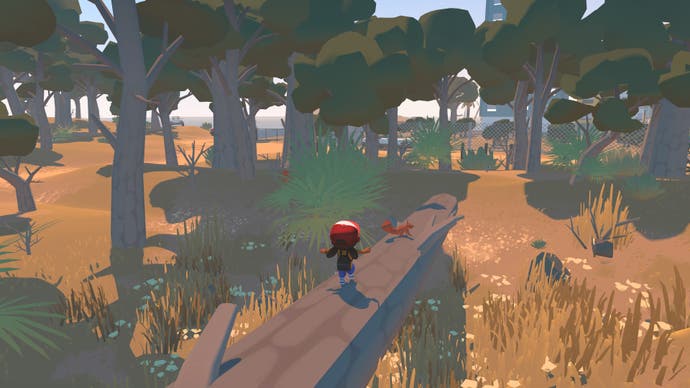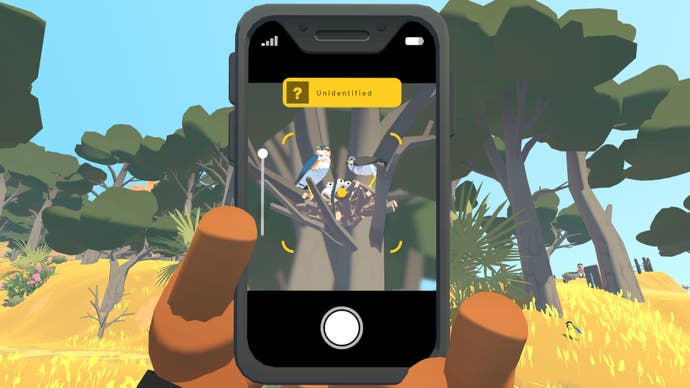Alba: A Wildlife Adventure review - the pleasure of fixing things
Twitcher gaming.
Restore. Every now and then I pluck the watch apart and fix it. It only takes a few minutes. The backplate with its four screws and engraving that reads, "Love always." The cracked movement with its gold and silver. The face, untouched, and the shattered crystal. It's a brisk business, and very easy on the ear. The busy whir of the screwdriver, the dance of screws in the china cup that keeps them from getting away, the rushing, back-and-forth tick of the watch itself springing to life, so many parts meshing to create something entirely whole. Restore, the game says, and in some quiet way... This is the pleasure and the privilege of fixing things.
In Ustwo's Assemble with Care, the watch is not simply a watch - it's also a key to the watch's owner and the relationship they had with the person who gave it to them. In UsTwo's next game, Alba: A Wildlife Adventure, you go bird-spotting on a beautiful Catalonian island, and the birds are not simply birds. They are the first interaction with nature, the start of a journey that leads to tidying the place up and starting to understand it. There's a story here, in which you collect signatures to stop a posh hotel being built on a nature reserve, but the real narrative is one of re-engagement. You start to notice the natural world and uncover its various pieces. You seek to restore. Again, the pleasure and the privilege of fixing things.
Pinar del Mar is a wonderfully snug open world, but it's also the Spanish holiday island of everyone's dreams: small enough to come to inhabit in the mind, but varied, with a church, an old fort, farmland, lakes, a town centre with cafes and shops and a bleached promenade. Flamingo inflatables are hitched to metal racks on sale down by the sea, while real flamingos totter and stalk through the reeds inland. There's a forest where the trees create cool shadows on the sand. There are cats rolling around in the heat and napping under faded canopies.

I have been to places like this and I recognise it with real pleasure. The details are beautifully observed, right down to the rebar poking out of the second storey concrete pillars of half-completed houses, right down to the plastic tables around the ice cream place. In Alba, you get to explore all this for the first time again, as a young kid on the island to visit her grandparents for summer.
More delightful observation: the dreamy emoji smirk that travels from one side of the face to the other, the cross of Muppet and Schulz cartoon visible in the irrepressible smile of Alba's best-friend Ines. Most of all the way that a trotting run from one objective to the next will always lose its focus and break into a brief skip, then switch back to a run - easily distracted, even in movement. Just perfect.
Alba and Ines are the stars here, a duo who are intent not just on foiling the mayor's destructive development plans but on looking after the island's wildlife. This plays out as a series of missions, generally involving traveling to specific spots on the map and helping people out, but it never feels like a sequence of missions. It feels like a series of good deeds that come naturally.
And they are all handled with simplicity and a lovely sense of pay-off. Throwing litter into a garbage can sees you hammering the controller button with a real pace and then delighting in the heart emoji that tells you the job is done. There is the mechanical reward of a pinball machine to it, and somehow it fits. Repairing a bird box sees fresh occupants flying in, and filling bird seed containers is equally brisk and satisfying. Even fixing walkways and plugging gaps in fences is little more than the press of a button, but it always feels like work that requires care. The animations have a kind of moral bustle to them, if that makes sense - this, then that, then what's next? Each good deed generally nets you another signature for your petition, but such is the pleasure of it all, you'd do it anyway.

At the core of all this is the wildlife. Your main task lies in cataloging the birds and bunnies and donkeys of the island, mainly birds, using a photo app to snap pictures and identify each creature. Local wildlife boards have scuffed photos that need replacing, but there's also something lovely about coming to recognise a call in the air or the shape of a bird on the wing. At one point I was sent for a glossy ibis and the sheer beautiful comedy of the bird in question, its kitchen hook neck and the levered, pot luck grin of its beak, offered all the sense of connection I suspect you get from real bird-spotting. I was enriched, and that was just an ibis. I almost gasped when I saw a kingfisher - a real, not-real kingfisher! A flame just perched on a fence. I love the fact that my in-game snaps are often blurs rather than neat silhouettes. The truth of a bird is that it moves.
All these animals are a delight when they're knocking about, and when you find them flapping in oil or trapped in the shrink-wrap handcuffs from an idle six-pack, it's impossible not to leap in and help them immediately. Again, it's all easily done, just a button press, but, again, you would do it anyway. This is an open world where you rarely feel like you're doing things purely to tick them off.
It is the start of something, I think, to learn the names of things. The start of bringing a neglected world into focus. Alba might simplify the business of caring for nature and defeating property developers, but it gets this central point absolutely right: the first step is to engage, to want to understand. That is where restoration begins, for a watch, for a nature reserve, for an island. The narrative here plays out over the course of a few days, and the whole map is open once the story is done. It left me eager to return, and it also left me pondering the strange luck of making a game like this at a time like this. When did development start?
As I pootle around Pinar del Mar now, tracking down those last birds, I think about old Spanish holidays, including one where we visited a cactus sanctuary that was home to a parrot called Stuart, and, coming back, we stumbled across a perfectly cheery Modernista graveyard. And I think about an afternoon this Spring, out on a government mandated walk on the South Downs behind my house, where the birdsong suddenly stopped, even the skylarks, who tend to flagpole themselves right up into the sky and then broadcast over a fixed spot like satellites. I looked around and then I saw it: a kestrel, I found out later, but in that moment it was a dim ghost in rusty feathers coasting silently over the distant grass.





